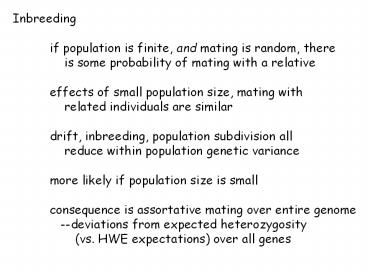Inbreeding - PowerPoint PPT Presentation
Title:
Inbreeding
Description:
Inbreeding if population is finite, and mating is random, there is some probability of mating with a relative effects of small population size, mating with – PowerPoint PPT presentation
Number of Views:157
Avg rating:3.0/5.0
Title: Inbreeding
1
Inbreeding if population is finite, and mating
is random, there is some probability of
mating with a relative effects of small
population size, mating with related
individuals are similar drift, inbreeding,
population subdivision all reduce within
population genetic variance more likely if
population size is small consequence is
assortative mating over entire genome
--deviations from expected heterozygosity
(vs. HWE expectations) over all genes
2
look at one locus, consider an individual who is
A1A1 1) random combination from unrelated
parents 2) identical by descent (both A1
alleles from a common ancestor)
F inbreeding coefficient probability
that an individual that is homozygous
carries two alleles that are identical by
descent, i.e., from a common ancestor
when a population is totally outbred, F 0 when
a population is totally inbred, F 1
3
extreme cases single fertilized
female---gtsib-mating single hermaphrodite---gtsel
fing
1 2
1 2
64
t
4
Calculating Inbreeding Coefficients from
Genealogies
What is the chance of a individual Becoming
homozygous due to alleles From the same source?
p 1/2
p 1/2
p 1/2
p 1/2
Chance of all events occurring (1/2) 4
However, there are four possible alleles that
could be Made homozygous due to inbreeding,
therefore the Probability of homozygosity due to
inbreeding is 4(1/2) 4 1/4 Inbreeding
coefficient
5
The chance of events occurring is again (1/2) 4
However, only two possible pathways Inbreeding
coefficient 1/8 F 1/8
6
(No Transcript)
7
extreme cases single fertilized
female---gtsib-mating single hermaphrodite---gtsel
fing
1 2
1 2
64
t
8
Measuring inbreeding Observed
Heterozygosity 2pq(1-F) or, Hobs / 2pq
1-F or, F 1 - Hobs/Hexp
Hexp 2pq
9
How Does F Change Over Time in a Population
Undergoing Inbreeding?
Ft (1/2Ne) (1) (1 - (1/2Ne))
(Ft-1) Ft 1 - ( 1 -
(1/2Ne)t in small popns, as t --gt 4, 1
(1/2Ne) --gt 0, Ft --gt 1 but, if Ne --gt 4, 1
(1/2Ne) --gt 1, Ft stays near 0
identical indentical by descent
by chance
in popns known to inbreed Ht Ho(1-F)t
10
Drift and Inbreeding May Occur in a Subdivided
Population A1A1 A1A2 A2A2 i
0.16 0.48 0.36 pi 0.4, qi 0.6 j
0.64 0.32 0.04 pj 0.8, qj 0.2 X
0.40 0.40 0.20 p 0.6, q 0.4 exp
0.36 0.48 0.16 heterozygote
deficiency
11
Estimates of Wahlunds fst For Bougainville
Islanders fst ABO 0.0522 Rh 0.0113 Gm
0.0767 Inv 0.0777 Hp 0.0563 PHs 0.0490
MNSs 0.0430 Mean 0.0477
12
Predicted Effects of Inbreeding 1) inbred
populations become genetically uniform no
longer respond to selection 2) inbred
populations may become phenotypically more
uniform due to loss of genetic variance 3)
inbreeding depressionfixation of
deleterious recessives and loss of selectively
favored heterozygotes leads to decreased
fertility, viability, etc.
13
(No Transcript)
14
(Lerner 1954)
15
lab studies have expected effects of
inbreeding but most field studies suggest
ecological rather than genetic factors cause
extinction in small populations
16
Saccheri et al. 1998 Nature 392491
Inbreeding depression in the Glanville
Fritillary, Melitea cinxia
Aland Islands in southwest Finland many small,
isolated populations 1600 suitable
sites 350-500 occupied sites
17
Model 1 Extinction Throughout Aland Islands
(1993-94) risk of extinction increases
with decreasing population size decreasing
density of butterflies in the neighborhood of
the focal population decreasing regional trend
in butterfly density modelling extinction risk
1995-96 data on heterozygosity ( 7
allozyme loci) for 42 popns 336 additional
populations with only ecological data does
genetic data improve models ability to
predict extinction??
18
extinct
alive
19
Effects of inbreeding on M. cinxia probability
of extinction is affected by global model
(n336 populations 185 extinct
1995-96) decreasing regional trend in butterfly
density decreasing habitat patch
size decreasing heterozygosity (increased
inbreeding) sample model (n42
populations 7 extinct 1995-96) small size in
1995 decreasing density of butterflies in the
area surrounding the focal population decreasi
ng abundance of flowers decreasing
heterozygosity (increased inbreeding)
20
Consequences of Inbreeding in M. cinxia reduced
rate of egg hatching reduced rate of larval
survival longer pupal period---gtincreased risk
of being parasitized shortened female
lifespan (lower female fecundity)
21
Inbreeding Results in the Loss of
Heterozygosity more likley to occur in small
populations (inbreeding and drift may both
contribute to loss of genetic variation) in
previously outbred populations, habitat
fragmentation (and smaller population size) may
lead to inbreeding and subsequent extinction in
species that routinely inbreed (e.g., parasitic
wasps) inbreeding is not deleterious

